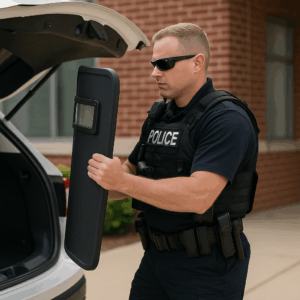Creating a safe environment for students and staff requires more than just physical barriers.
Schools need a dedicated team to manage safety and security efforts and a community-wide approach to ensure everyone is invested in protecting the campus.
Building a security management team and developing a “community of interest” are key steps in laying the foundation for a comprehensive safety plan.
What is a Security Management Team?
A security management team is responsible for overseeing the development, implementation, and ongoing evaluation of a school’s safety and security measures.
This team ensures that plans are not only well-designed but also practical and effective.
Who Should Be Involved?
- School Administrators: Principals or vice-principals who understand the daily operations of the school.
- Emergency Managers: Individuals trained in crisis response planning.
- School Resource Officers (SROs): Law enforcement officers with specialized training in school safety.
- External Experts: Professionals with experience in physical security audits, emergency planning, and training programs can offer objective insights and specialized skills.
Building a Community of Interest
School safety isn’t just the responsibility of administrators. It requires collaboration with a broader group, including internal staff and external stakeholders.
Internal Partners
- Teachers and Staff: They are on the front lines and need to understand their roles in safety protocols.
- Students: Educating students on safety practices empowers them to respond appropriately in emergencies.
External Partners
- Local Law Enforcement and First Responders: Their expertise ensures that plans are actionable and aligned with community resources.
- Parents: Engaging parents builds trust and reduces resistance to new security measures.
- Outside Experts: Security professionals provide specialized assessments and solutions tailored to the school’s unique needs.
Benefits of Collaboration
Bringing together a diverse group ensures that safety plans are well-rounded and practical. Key benefits include:
- Improved Planning: Collaboration ensures all potential risks are considered, from daily operations to after-school activities.
- Community Support: Engaging stakeholders reduces resistance to necessary security measures by showing their value and purpose.
- Stronger Emergency Response: Local first responders and security experts bring actionable insights that improve response times and effectiveness during crises.
How External Experts Can Help
Outside experts play a critical role in strengthening school safety. They offer an unbiased perspective and specialized knowledge, such as:
- Conducting Risk Assessments: Identifying vulnerabilities in facilities, policies, and procedures.
- Developing Emergency Operations Plans: Creating detailed, actionable steps for handling various scenarios.
- Training Staff and Students: Providing realistic drills and situational awareness training to prepare for emergencies.
By partnering with professionals, schools gain access to proven strategies and tools that enhance their security efforts.
A Strong Foundation for Safety
A dedicated security management team and a collaborative community are the cornerstones of effective school safety.
Together, they create a system that is proactive, inclusive, and equipped to handle challenges.
Need help improving your school’s safety plan? Contact Risk Strategy Group today for expert guidance on building your security team, conducting risk assessments, and training staff.






